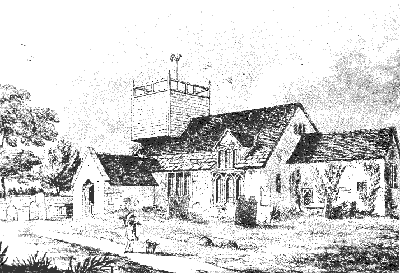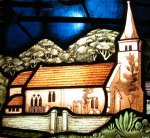
Parish History
Some Glimpses of Northwood
by Anne Brooker, Churchwarden
In 1086, at the time of the Domesday Survey, the parish of Northwood was covered by the ‘northern wood’ of Parkhurst Forest. Any habitation within that area would have consisted of clearings and farms. In the Domesday Book only Luton, Levintune, is mentioned. It is described as being held jointly by the King and Wulfgeat the Hunter. In 1066 it was worth one hide, in 1086 only half a hide (A Hide is a measurement of land area equal to 120 acres). There was land for two ploughs, which were held by four villagers and two smallholders. There were also two slaves and woodland for fencing. The value of the holding was 20 shillings (£1).
Northwood stood within the area of the large medieval parish of Carisbrooke. The church was built at some time in the 12th century, which would seem to indicate that there were enough inhabitants to provide tithes for its upkeep. Records show that Northwood paid tithes to the value of 30 marks to the mother church at Carisbrooke (Tithes were taxes of one tenth of the annual produce of land or labour taken for the support of the clergy and church). In 1264, in a confirmation by Isabella de Fortibus, Lady of the Island, to the Prior of Carisbrooke, Northwood now existed as one of the four chapels of Carisbrooke, the others being Newport, Shorwell and Madaderia (Madaderia was a leper chapel of St. Augustine at Gunville).
Services were taken by a monk from Carisbrooke Priory but parishioners went to the mother church for baptisms, burials and special saints days. The latter undoubtedly took on a social character (an early church outing?) Congregations, banners aloft, were forbidden to race in order to arrive before another at the mother church. Burials continued to take place at Carisbrooke until ground was consecrated for them at Northwood in 1486.
The building of the original church took some years, and once finished in the early part of the 13th century Northwood saw no major work for 200 years. The fabric of the church dates back to the Transitional Norman period when Norman architecture was giving place to the ‘Decorated’ style. The south doorway has a magnificent Norman arch with chevron moulding. It is not in its original position and must have been moved and rebuilt when the south aisle was added, early in the 13th century. The north arcade, with its circular columns, is also of the Transitional Norman period.
The parish of Northwood had one of Carisbrooke’s four tithe barns. Accounts survive of one John de Kyngeston, custodian of the rights of the Abbey of Lyle, for the year 1351-1352. The Priory at Carisbrooke was owned by Lyle, an abbey in Normandy. The document states that the corn was sold from the tithe barn. The straw was kept for thatching the roof, which needed extra straw on. It is noted that the thatchers were paid, but not the sum involved. A new lock was needed for the door, as were repairs to the wall near the gate. The chancel was re-roofed, a task that took a man and a lad nine days.
John de Kyngeston also paid for the winnowing and threshing. Carts were hired to bring in the corn and, as was customary, the harvesters received gloves to protect them against thistles. The sum of 4s 3d was spent on a repast for the parishioners ‘to encourage them to pay their tithes more readily’.
The Northwood barn had stored wheat, barley and oats, all of which had been sold. There were also the lesser tithes – 7 calves, 29 lambs, 3 piglets, 4 cocks, 16 hens, 20 pigeons, 58½ cheeses, 8 stone 6½ lb. of wool, and the tithe of the mill at Freshwater. They were sent to Northwood from Brook (the wool), Freshwater, Compton, Chessel, Afton, Wellow, Ningwood, Appuldurcombe and Wroxall.
The next century, the 15th century, saw new work being undertaken on the church. Windows were inserted in the outer walls and the two flying buttresses were thrown across the aisles to counteract the outward pressure of the nave walls at these points. The chancel was also re-roofed at this time, if not entirely re-built. Above the chancel arch at the east end of the nave two corbels still exist, which would seem to suggest an earlier and possibly shallower pitched roof.
Early in the 16th century a religious brotherhood styled ‘Brothers and Sisters of the Fraternity of St. John the Baptist’ (an early Friendly Society) was established at Northwood. Records show that in 1512 two or three strips of land were conveyed to their stewards by one John Wynnyatt. The Fraternity, together with similar bodies, was suppressed when Henry VIII’s ‘Dissolution of the Religious Houses’ was enforced in 1536. The building which was used by the Fraternity was located near the Church and called ‘Church House’. It was apparently still standing in 1690.
In 1545 Northwood was freed from paying any church rate, about forty shillings a year, to the mother church, Carisbrooke. The inhabitants also enjoyed full parochial privileges from this time, although Northwood remained annexed to Carisbrooke and was supplied by the same with a curate. The church registers date from this time.
Later in the 16th century some of Northwood’s parishioners refused to follow the new Protestant religion. On July 29th, 1570, the Court of Recusants recorded that Thomas Dingley, Richard Cawse and his wife, and Richard Spalding and his wife were non-communicants, by which action they risked fines and imprisonment. Christina Willford (widow) ‘refused to come orderly to the parish church and is very negligent therein’. For this she was excommunicated.
In 1699 St. John’s was left one of its most important charities, commemorated on the board over the south door. Richard Smith of London, goldsmith, desired to be buried near his parents at Northwood. He also directed that his sister, Jane Spinks, should be re-interred there. Richard left £200 to St. Mary’s, Woolnoth, for the purchase of land, the income from which was to finance an apprentice from Northwood ‘every second’ year. Forty shillings per year was also left to provide bread for the poor. The Smith charity, also on the board, dates from this time and was also for apprenticing.
It is important to remember that from the time of the Reformation until the 19th century Cowes was part of the parish of Northwood, so parish administration had to include the whole of the area. As the size of Cowes increased, so did the influence of its wealthier inhabitants on the parochial affairs of Northwood.
By an act of 1597 the overseers of the poor in each parish were given the power to levy a rate to support their poor. By 1662 anybody below the status of property owner not originally settled in the parish could be removed to his own parish unless he could give security that he would never come on the Rates. The registers record the work of the Overseers of the Poor. The idea of the old Poor Law was to provide the poorest with a safety net from birth to death. The Overseers could use their discretion in dealing with the poor, but the administration of the law within a parish very much depended on the quality of the individuals elected as Overseers within each parish.
Each parish had a cottage ‘poor house’ to shelter the homeless. In 1723 parishes were empowered to establish workhouses in which able-bodied paupers were made to work and the infirm fed at the parish expense. The workhouse had a master and mistress employed by the parish. Northwood was one of the first to open a workhouse, in 1727, on a five-acre site near the church. This workhouse remained in being until the building of the House of Industry at Newport in 1774.
An example of how the Poor Law system worked can be seen from the minutes of Northwood Vestry for 1831. Present at the meeting were:
John Breeks (Minister)
Thomas Wilkinson and Thomas May (Churchwardens)
Edward Knell (Guardian of the Poor)
James Roberts and John Attrill (Overseers of the Poor)
The April rate for Relief of the Poor was set at 1s 9d in the £1
Some premises mentioned and their respective Rateable Value were:
John Attrill, Nodes £97
Rev. Breeks, house and land £24
George Baker, Flower Pot £5
Jo. Jerram, Horseshoe £5
Somerton Farm £50
Dennison, Medham £50
Wm. Saunders, Wroxall Farm £23
Tho. Wilkinson, Chawton £107
In 1835 the Church Vestry records a list of names, sent to the House of Industry, to take apprentices. Three years later twenty people were nominated to take apprentices from the House of Industry. These included William Newman of Crockers Farm, Thomas Wilkinson of Chawton, John Cook of Sticelett and James Dawson of Furzy Hurst. Not everyone paid their Poor Rate willingly, and in 1849 it was stated that all defaulters on the Poor Rate were to be listed quarterly, with the list being fixed to the church door. 1855 saw the end of the vestry system as it had been known: an act ‘to prevent the holding of vestry or other meetings in churches, and for the regular appointment of vestry clerks’ was to be applied. Future meetings were to be held in Cowes Town Hall.
The mid-19th century saw extensive ‘restoration’ work carried out on the church. Until this time, as a 1794 print shows, the west end of the church was surmounted by a curious, square, wooden tower, almost as wide as the church itself. There was also a large dormer window at the east end of the south wall of the nave. In 1864 both were swept away in the Victorian passion for making everything look as Gothic as possible. The restoration, paid for mainly by Miss Emma Ward, was completed in 1874. It is recorded that a large party was invited to dinner the day before the opening service when ‘Dean Hook preached’. Northwood’s only bell was hung in 1875.
|
Left: Print of Northwood Church 1794
|
Kelly’s Directory of the Isle of Wight (1886) states that the living of Northwood was a chapelry, annexed to Carisbrooke, with a joint yearly value of £1,162 and 53 acres of glebe in the gift of Queen’s College, Oxford, held since 1858 by the Rev. Charles Boucher James MA of Queen’s College. The Rev. Charles Edward Seaman MA of Corpus Christi College, Cambridge was the resident officiating curate. Memorials to both men can be seen within the church.
In 1840 it was stated that the parish extended from ‘Parkhurst to the Solent’ and included both the prison and the barracks. By 1881 the population was 8,484, of which 358 were in Parkhurst Prison and 7,072 were in West Cowes. This situation did not last many more years as in 1894 the parishes of St. Mary’s, Cowes, and St. John the Baptist, Northwood, became separate entities.
The last century saw in Northwood, as elsewhere, a great many changes, with agriculture as the principle occupation giving way to industry as the major employer. Although described as a ‘peaceful backwater’, the two memorial tablets on the north wall of the church indicate that Northwood was, sadly, not immune from events in the outside world. The church itself has had to face changes and latterly outside pressures have meant sharing our clergy with two other parishes.
We can only hope that whatever this present century holds for Northwood we may continue to be seen as a place where ‘the atmosphere is warm and friendly’ and where ‘the church is obviously thriving’.
© Anne Brooker 2002
Friends of
Northwood Church
Founded as an independent organisation its object is to raise money for the upkeep of the building of St John the Baptist, Northwood.

